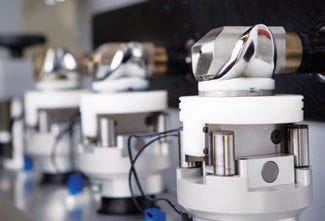February 1, 2012
With its aging yet increasingly active population, the United States has experienced a proliferation of total knee replacements in recent years, necessitating increased testing to prevent device failures. However, while knee simulator machines have conventionally relied on simplistic linear models provided by mechanical springs to incorporate the effects of soft tissues on joint motions, these methods often return findings that differ from those observed in patients. Now, AMTI has developed a technology that enables medical device manufacturers to simulate the influence of the soft tissue on joint motion to create more-realistic tests for knee implants.
|
AMTI's technology enables medical device manufacturers to simulate the influence of the soft tissue on knee-joint motion. |
"Our simulators use a system of actuators to apply forces to the prosthetic device--much like the forces that the musculature, body dynamics, and gravity provide," comments Bruce White, AMTI's CEO. "When used in conjunction with our Virtual Soft Tissue (VST) control system, these simulators allow implants to react the way they would as an integrated part of the knee."
When the knee bends, the soft-tissue structure provides a constraining force that holds the joint together and may share a significant part of the knee load, White explains. However, representing this dynamic play of forces in a testing environment poses a significant challenge. A common approach involves using metal springs to mimic the elastic nature of the ligaments. But the increasing resistance of a metal spring is purely linear, while the force displacement characteristics that occur in the knee are asymmetric and nonlinear.
In contrast, VST accounts for the complex effects of the soft tissue in any given position as the simulator applies forces to the prosthetic device. "VST is essentially a good set of springs, but in data, not physical, form," White says. "It's a very detailed stand-alone set of data about how the human knee actually works, enabling designers to develop a testing scenario that more closely mimics normal human motion so that they can get better data about how their design will function over time."
AMTI's simulator machines are programmed with waveforms representing the forces that designers expect the knee implant to encounter during normal use. Relying on walking-gait waveform standards developed by the International Society of Standards and ASTM International, the system subjects the prosthetic device to millions of cycles of motion.
Testing capabilities have increased over the years, enabling designers and manufacturers of orthopedic implants to conduct tests using more-complex, more-accurate simulations, White says. And while standardized testing is currently available for normal walking gait only, simulations for motions that cause higher loading on the prosthetic--such as going up and down stairs, sitting and standing, and turning--are being developed.
"More-comprehensive testing models hopefully are forthcoming," White says. "Certainly they, too, can be programmed into our machines."
AMTI
Watertown, MA
You May Also Like



